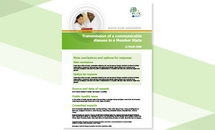Zika virus transmission worldwide
Most countries in the Americas and the Caribbean have witnessed a decline in cases of Zika virus (ZIKV) disease since 2016, with apparent interruption of transmission in several islands. In Asia there seems to be a wide geographical distribution of ZIKV, whereas in Africa information is limited. This report assesses the risk of ZIKV for travellers, the risk for pregnant women, the risk related to sexual transmission, the risk related to substances of human origin and the risk of importation into the EU/EEA.
Executive Summary
This rapid risk assessment addresses the evolution of the ZIKV disease epidemic since 2016. It was triggered by the recent update of World Health Organization (WHO) guidelines for the prevention of sexual transmission of ZIKV, the recent identification of three Zika travel-associated cases in travellers from Denmark and Norway returning from Thailand, and a case of sexual transmission from one returning traveller. The report assesses the risk for EU/EEA travellers, the risk for pregnant women, the risk related to sexual transmission, the risk related to substances of human origin and the risk of importation into the EU/EEA.
Symptoms associated with Zika virus infection are generally mild and most of the people infected do not develop any symptoms. However, for pregnant women and their developing foetuses there is a risk of congenital Zika syndrome and other complications including preterm birth and miscarriage. ZIKV is also associated with severe neurological disorders, mainly Guillain-Barré syndrome.
Pregnant women and their partners, and couples planning pregnancy, should be provided with comprehensive information about the risk associated with ZIKV infection as well as all other infectious agents which can impact the pregnancy and cause foetal development disorders, such as the so-called TORCH agents (e.g. rubella virus, cytomegalovirus, Toxoplasma gondii) which are distributed worldwide. According to the new WHO guidelines for the prevention of sexual transmission of ZIKV, the duration for correct and consistent use of condoms or abstinence from sex with an infected partner is reduced from six to three months for men, and two months for women. To prevent potential infection of the foetus, the consistent use of condoms or abstinence is recommended for the whole duration of an ongoing pregnancy.
Current Zika transmission
Since the epidemic in the Americas peaked in 2016, most countries in the Americas and the Caribbean have witnessed a decline in cases, with apparent interruption of transmission in several islands. In Asia, investigations and epidemiological surveillance suggest a wide geographical distribution of ZIKV whereas in Africa, information about ZIKV circulation remains limited.
The main mode of transmission is through the bite of an infected mosquito, although few sexual transmission events have been reported. The risk of infection depends therefore on the local risk of mosquito-borne transmission. It may be high during epidemics, but lower levels of ongoing virus circulation are still expected in areas where ZIKV circulation is considered endemic; in these areas the risk of is low to medium.
As a precautionary principle, areas where ZIKV has been reported historically, but where there is limited capacity for disease surveillance may be considered of low to moderate risk.
All residents of, and travellers to areas with ongoing or historical transmission should prevent mosquito bites, and be able to make informed decisions on whether to abstain from sex, practice safer sex, or avoid/delay pregnancy. In areas where transmission has been interrupted and without ongoing transmission, re-introduction of the virus might occur, but the probability of large outbreaks is currently low due to herd immunity in the population. The likelihood of exposure for residents and travellers in such settings is negligible.
Options for prevention
EU/EEA Member States should consider communicating the risks of ZIKV to the general public, including the possibility of transmission by mosquitoes, from sexual activity, or from substances of human origin. Medical practitioners in travel clinics should be aware of the current ZIKV epidemiology during their pre-travel individual risk assessments. Health professionals providing antenatal care, obstetricians and paediatricians should also be aware of current ZIKV epidemiology in order to identify and investigate pregnant women exposed to ZIKV during their pregnancy and monitor the neurological development of their children.
Clinicians should remain alert to the risk of ZIKV infection in travellers returning from areas with ongoing or past transmission and the risk to their sexual contacts in the EU/EEA. Depending on their national guidelines, they may consider testing for ZIKV infection of those with compatible symptoms.
Download





